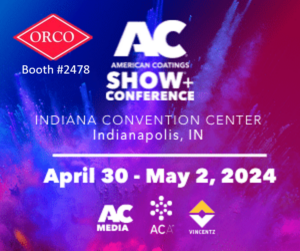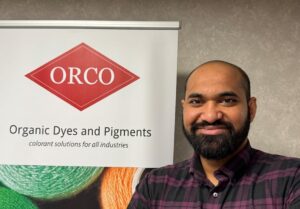Orco™ Acid Dye Description, Storage, Handling, and Preparation
Description
The Orco Lanamide™ product line consists of non-hazardous, non-chrome dyes applicable to nylon, wool, and blends thereof and offer high fastness, brightness, and compatibility as a group and are especially suited for the sport and swimwear trade as well as high-tech “smart wool” composites.
OrcoAcid™ dyes find use in the piece dyeing of wool and worsted goods. Their inherent excellent leveling properties and wide shade selection make them especially suited to the men’s and women’s wear industry. These colors are generally applied from a strong acid bath(pH of <3.5). Some, such as the Alizarine dyes, are better applied from a weak acid bath (pH of 3.5-6.0).
Orcolan Fast™ dyes for wool represent a group of 1:1 acid metalized dyes (chrome complex) with excellent leveling properties in strongly acid conditions such as carbonized wool. Although this line is somewhat limited in shade range it is very popular due to its ease of application and good fastness properties and finds wide use in stock dyeing especially in those areas destined for cross dyes (checks).
Orco Milling™ dyes are characterized by their high wetfastness and their wide range of bright colors. Although their lightfastness properties are less than the metallized group of acid dyes, they do offer a brighter shade range to choose from. These dyes are used primarily in stock and package dyeing but have been used in piece dyeing where careful temperature and pH control is possible.
Orco Nylosol™ dyes are characterized by their excellent leveling and penetrating properties in addition to their wide range of bright colors. Although this range does not exhibit the high wet and light fastness properties of the Milling and Metallized dyes, when selected carefully and after-treated properly, very acceptable fastness may be achieved. This class of dyes consists of two groups, each having somewhat different affinity for nylon and requiring slightly different application methods:
Type A: These are acid leveling dyes of a higher molecular weight which have a stronger affinity for the nylon than the B types and should be applied at a neutral or weakly acid pH. The use of buffers and acid donor salts is generally recommended.
Type B: These are acid leveling dyes of a lower molecular weight having less affinity for the nylon than the type A dyes and so require a lower pH(2-3) to promote good exhaustion and reproducibility.
Orcolan Neutral™ dyes are 2:1 premetallized dyes and because of their large molecular size behave similarly to the acid milling type dyes in application and strike rate. Because of the metal complex (Cr+3 usually), these dyes exhibit excellent light and wet fastness and find application in the automotive /industrial fabrics. Because of the rapid rate of exhaustion, these dyes should be applied from a neutral or slightly alkaline pH. The use of an acid salt such as ammonium sulfate with or without a buffer is highly recommended. The pH is gradually lowered later in the dyeing cycle by the use of glacial acetic acid. These dyes are suitable not only for piece dyeing but also stock and package work. One limitation of this line is the general lack of brightness but for the majority of shades encountered, the line is sufficient. Although not actually included in this line, the Orcolan Fast™ Acid dyes which are a 1:1 metallized type should be mentioned only because they also contain Cr+3 and exhibit excellent fastness. The acid metallized dyes differ from their neutral counter-parts in that they require strongly acidic conditions(pH of 2) to exhaust which may cause some fiber damage to both nylon and wool. One advantage this type of dye does have is its ability to level very well.
Orcoset™ dyes for nylon and wool are a special group of modified 1:2 metal complex and reactive dyes exhibiting high fastness levels and similar dyeing properties. All dyes are applied at a pH of 4.5 in conjunction with Orcogal SET™. These dyes find application in stock, piece, and package dyeing. These dyes do not require an ammonia after-scour to achieve wet fastness.
Storage
Orco™ Acid dyes should be kept in a dry area and elevated so container is not in direct contact with the cold ground which may cause condensation and eventual caking of the dye. Each drum of dye should be spaced far enough away from each other to prevent cross-contamination when drum lids are removed and the dye is transferred. All dyes should be stored in a separate room from chemicals to avoid contamination from air-borne dye dust. Drum lids should be replaced immediately and sealed to prevent cross-contamination and minimize moisture buildup. Utensils used to remove the dye from the drum should be perfectly clean of any dirt, chemicals, or other dye.
Handling
As with any dye or fine-particle material, the proper NIOSH-approved respiratory mask should be used when handling dyes. Operator should review Safety Data Sheet(SDS) and wear proper protective clothing allowing no direct skin contact.
Preparation
Soft water should be added slowly to preweighed dye in suitable bail-up container and then add steam slowly to prevent excessive frothing. The weight ratio of water to dye should not exceed the solubility of the dye. Boil the dye solution or add more steam to insure all dye is completely dissolved into solution. Make sure the steam is not generated from hard water or water which contains metals or high levels of chlorine. If necessary, agitate with a mixer and dilute with hot water. Before adding to the dyebath, the dye solution should first be passed through a fine-meshed screen.
Shelf Life
The shelf-life of Orco™ acid dyes in a sealed container is estimated at 5-8 years for powders and 1 year for liquids when stored in a cool, dry, and dark environment.



